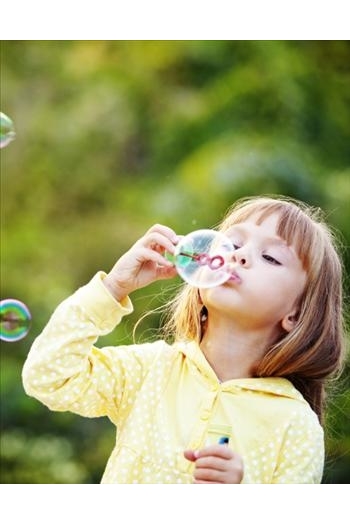Blowing bubbles
Duration/age

Blowing bubbles can be a fun activity to do on a very windy day. Watch the wind catch the bubbles and lift them high into the air. Try and track an individual bubble. As the wind catches the bubble and lifts it higher make predictions as to how high it will climb.
Will it climb over the fence or even over the roof of the house?
Hold and point the bubble blower differently and watch to see if the bubbles travel in different directions. Does it make a difference or will the wind still catch the bubble and float it quickly up into the air?
Can you run after the bubbles and catch them on your hand or do they pop before you get there? See who can blow the most bubbles.
If you catch one does it pop?
Take a very big breath of air and see how long you can blow through the bubble blower. Can you count the length of time in your head or do you need someone to count out loud for you?
How many bubbles can you make?
Materials you will need
- Bubble wands
- Bubble blowers
- Containers to fit the bubble wands
- Bubble mix
Alternative tools
- Ice-cream container
- Wire coathanger
- Florist wire
- Dishwashing liquid and water mix
Skills this activity improves
Why does this matter?
Blowing bubbles is an opportunity to explore counting, distance, speed, direction and to experiment with the different language that is used to describe measurement. As the wind catches the bubbles explore the different ways that you can describe distance. You could talk about how far the bubbles travel as a measurement of time or as a description of height.
What does this lead to?
As you blow bubbles together you will be exploring the many different ways that we can measure and you will be discovering that measurement is not only counting and numbers. By describing what is happening as the bubble floats along, you will be modelling the different types of language that we use to describe measurement and the language we use to identify where an object is located and how the object travelled to get to that location. Talking about measurement helps children to understand how to interact with an object. If we talk about temperature children learn if something is hot and to be careful, compared to if something is cold. When we talk about distance or speed children begin to explore how long it will take to get to a place.
Language to use
- High, low, up, down, over, under, in, out
- Fast, slow, quickly, speed
- Hard, soft, blow
- Direction
- Wind, calm
- Small, large, big, little
- One, lots, many, some, more, few
- Pop, bubble, mix, container, wand
- Round
Questions to use
- How fast do you need to blow?
- How many bubbles did you blow?
- Who blew the most bubbles?
- Which bubble is the biggest?
- Which direction are they going?
- What happened to the bubbles?
Useful tips
- Ready-made bubble mix and bubble wands can be purchased in most supermarkets and discount shops.
- Bubble mix can be made using dishwashing liquid and water.
- Bubble mix can run down hands when blowing bubbles. It can be handy to have a wet towel with you to wipe little children's hands before they rub their eyes. See Living with Toddlers for safety information.
- If you are using homemade bubble mix using smaller containers will make it easier for younger children to help with holding and pouring.
- Remember to talk to your child in your home language.
More ideas
- Use wire coathangers or florist wire to make bubble blowers of different shapes and sizes.
- Try adding vegetable dye to the bubble mix and then blowing the bubbles onto paper to create bubble pictures.
Variation by age
Three to five year olds
- Set up a soapy sponge tray using sponge offcuts and a small amount of water and dishwashing liquid. See how hard you need to squeeze the sponges to create foam and bubbles.
- Use a stopwatch or timer on your mobile phone to measure how long before the bubbles burst.
- Make measuring sticks and place them around the yard. Blow your bubble and see if you can float your bubble over the top of the stick. Whose bubble flew the highest?
Questions to ask
- What shape is that?
- Which stick is the tallest?
- Whose bubble went the furthest?
- How long did the bubble float for?
- How far do you think it will float?
- Which is furthest?
Language to use
- Closest, furthest, nearest, longest
- Over, under
- Measure
- Tall, short, height, length, distance
- Hard, soft


